Key takeaways:
- Source evaluation is critical in genealogy research to ensure the accuracy of family histories; each source should be scrutinized for credibility and context.
- Credible sources, like official records, form the foundation of reliable genealogical work, while oral histories and secondary sources require careful validation.
- Understanding the author’s expertise, publication date, and context of the source enhances reliability; discrepancies between documents should prompt further investigation.
- Utilizing digital tools like spreadsheets and organizational apps can significantly improve the efficiency of managing and evaluating genealogical sources.
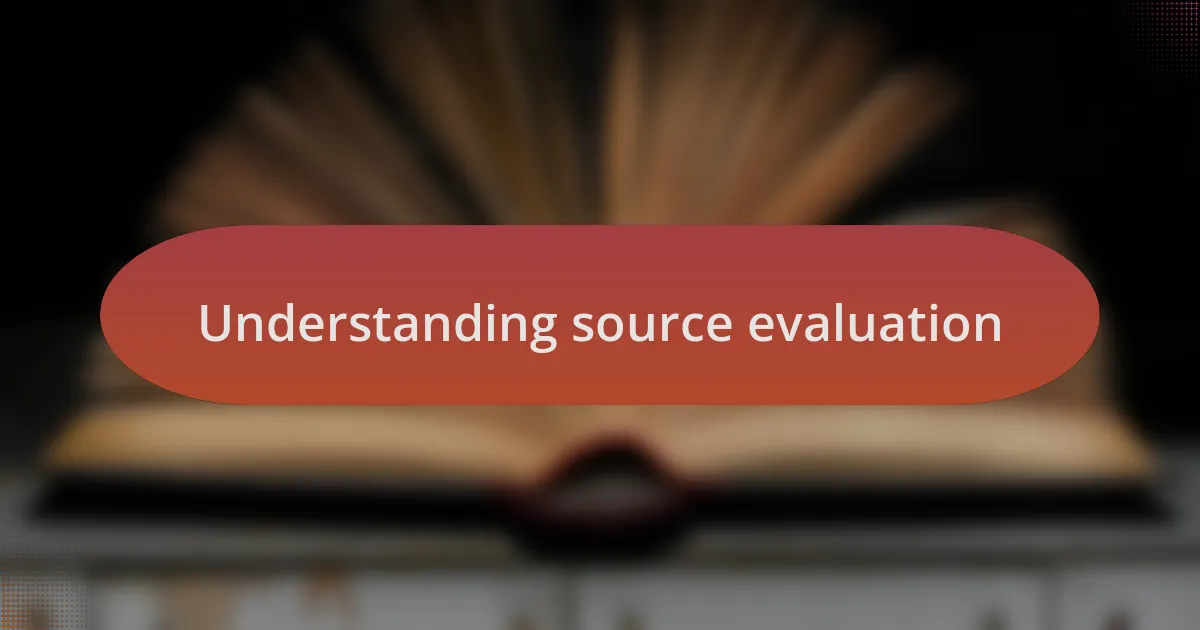
Understanding source evaluation
Understanding source evaluation is crucial in genealogy research. It’s like piecing together a puzzle where each source adds a layer of understanding to your family story. I remember when I stumbled upon an old newspaper clipping about a relative, and it seemed perfect at first. But as I dug deeper, I realized it lacked proper context, which ultimately led me to question its reliability.
Have you ever found a family tree online that seemed too extraordinary to be true? That’s a common pitfall. I once came across a source that claimed my ancestor had a royal lineage, but the lack of citations made me skeptical. Evaluating the credibility of such claims helps prevent us from building a family history on shaky ground.
In my experience, I’ve learned that a source’s origin, authorship, and purpose matter significantly. When I encountered a personal account from a family member, it felt moving and authentic. Yet, I also knew I had to compare it with official records to ensure the story was accurate. Balancing emotional resonance with rigorous evaluation is key to tracing our roots effectively.
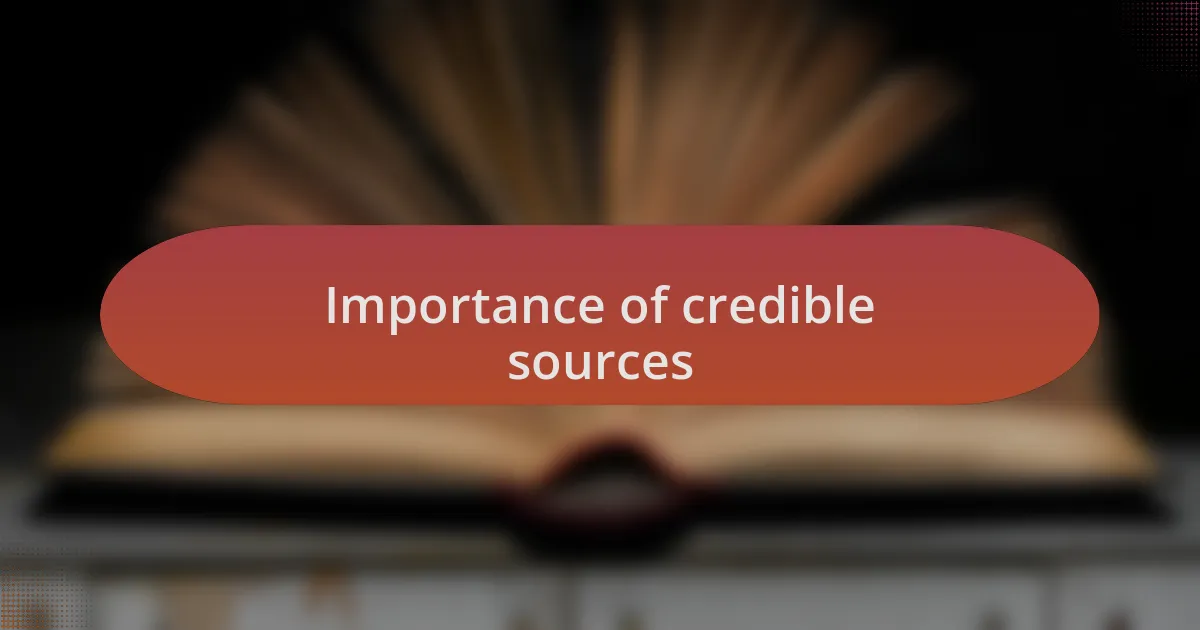
Importance of credible sources
Credible sources form the backbone of any meaningful genealogy research. When I first started exploring my family tree, I was tempted to accept oral histories without questioning their origins. It wasn’t until I encountered discrepancies between family stories and official documents that I realized the importance of verifying facts. This experience taught me that every source, no matter how convincing, needs to be scrutinized for accuracy.
Consider a time when you uncovered a fascinating detail about your ancestry, only to wonder whether it was truly reliable. In my own research, I occasionally faced such moments, like discovering a birth record that didn’t match other vital statistics. This discrepancy made me pause and reflect on the critical need to establish a source’s reliability. In genealogy, a solid foundation built on credible sources minimizes the risk of perpetuating errors and myths.
Ultimately, without credible sources, your family history may become more fiction than fact. I recall a colleague sharing a vivid tale of an ancestor’s adventurous life, excitedly recounting it as if it were gospel. However, that story was rooted in hearsay. I quickly recognized that without credible documentation to support it, such narratives could lead to misleading conclusions about our heritage. Trust in credible sources is essential; otherwise, we risk losing the truth of our past.
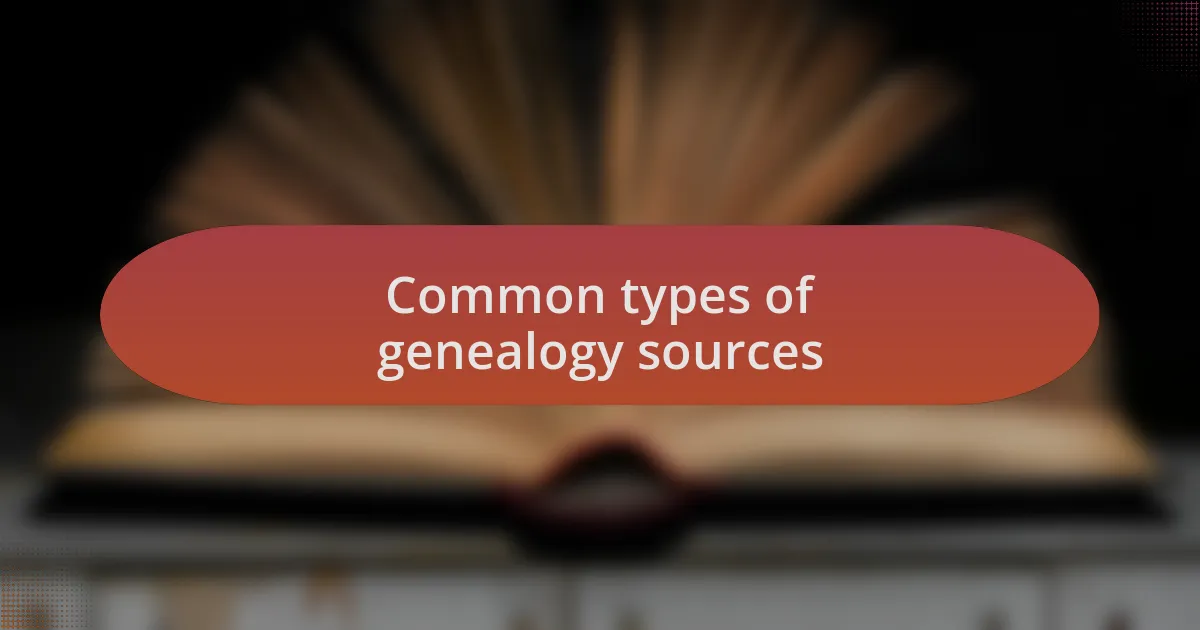
Common types of genealogy sources
Genealogy sources can be categorized into several common types, each with its unique strengths and weaknesses. Official records, such as birth, marriage, and death certificates, serve as primary sources. I remember the thrill of finding my great-grandmother’s marriage certificate; it illuminated not only her name but also offered a glimpse into the lives of her parents. These records are invaluable since they provide factual data often confirmed by government agencies.
Another significant type of source is secondary sources, which include books, family trees, and historical accounts crafted by other researchers. While they can be helpful for context, I’ve learned the hard way that secondary sources should be treated with caution. For instance, while researching my family history, I came across a well-regarded book that contained a detailed family tree. However, a few branches didn’t match my findings through official records. This experience solidified my understanding that while secondary sources can suggest valuable leads, they require validation against primary records.
Oral histories are also common in genealogy, passed down from one generation to the next. While these stories hold sentimental value, they often blend fact with fiction. I once listened to my grandmother recount tales of a distant relative who supposedly fought in a famous battle. Exciting as it was, I later discovered that certain details were embellished over time. This revealed a key lesson: while oral histories can enrich our understanding of ancestors, they should always be cross-referenced with more concrete evidence to separate fact from folklore.
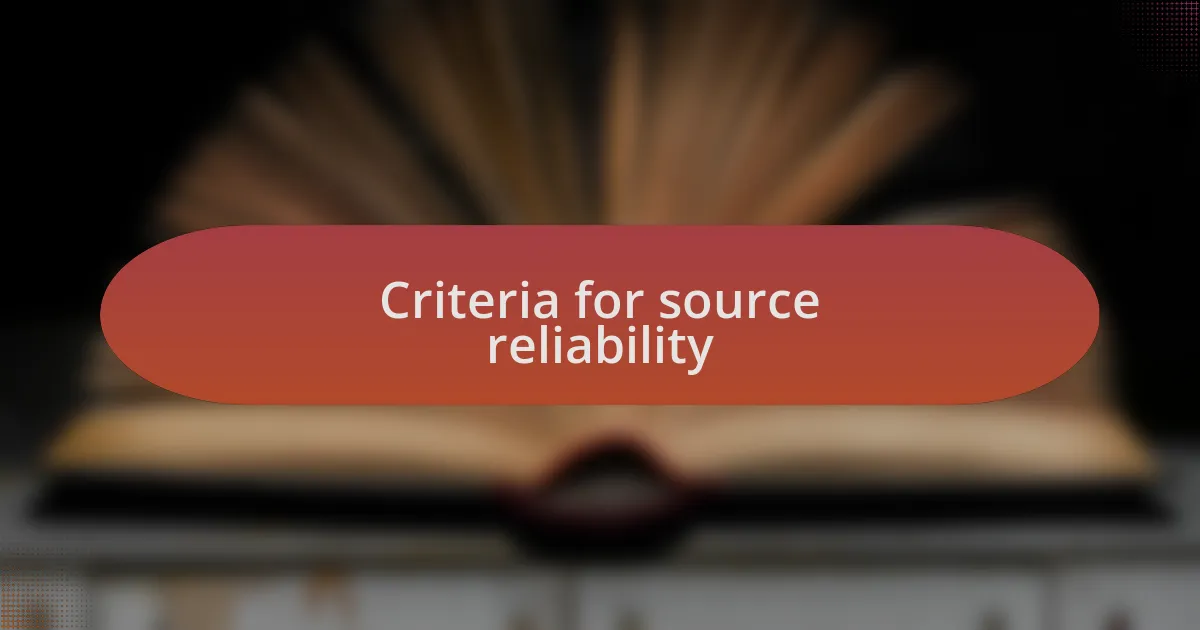
Criteria for source reliability
When evaluating source reliability, the authoritativeness of the source is crucial. Official records, such as census data and legal documents, are highly reliable because they are typically subject to rigorous validation processes. I recall the excitement I felt when I accessed a digitized census from the late 1800s; it didn’t just provide names but also presented my ancestors’ occupations and locations, solidifying their presence in history.
Equally important is assessing the publication date of a source. Information can quickly become outdated in genealogy, especially with evolving documentation and historical research methodologies. I once discovered a guidebook about my family’s region that was published in the 1980s. While it offered fascinating insights, I realized that some of the trends and interpretations were no longer accurate. This experience has taught me to critically consider how recent the information is, ensuring I’m not relying on obsolete data.
It’s also essential to think about the author’s expertise. An author with years of experience or credentials in genealogy will likely produce more trustworthy work than a casual blogger. I remember reading a blog about genealogical methods written by an amateur enthusiast. While it contained passion, I quickly identified several inaccuracies compared to scholarly resources. This highlights why diving into the background of a source’s creator can be a vital part of ensuring reliability in your research journey.
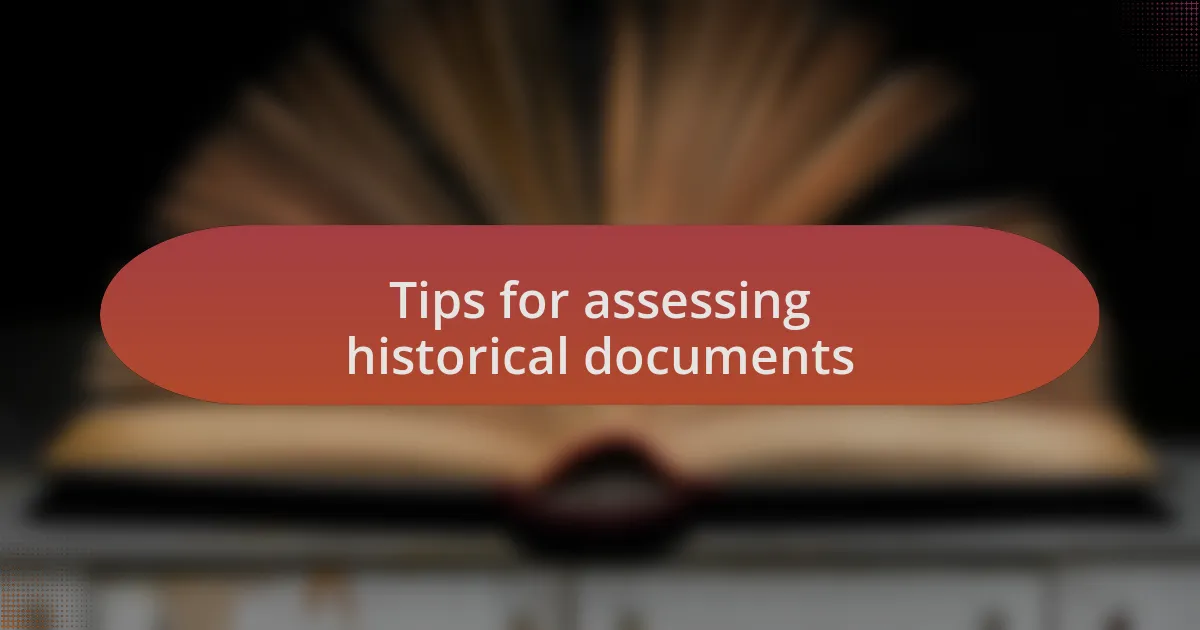
Tips for assessing historical documents
Assessing the authenticity of historical documents is fundamental. When I stumbled upon an old will from the 1700s tucked away in an archive, I felt like I was stepping back in time. However, I learned quickly that such documents must be scrutinized for forgeries or alterations—the ink, paper quality, and even handwriting styles can reveal much about the document’s legitimacy. Have you ever wondered how many family stories hinge on the accuracy of a single piece of paper?
Understanding the context in which a document was created can also enhance its value. I remember analyzing correspondence between my ancestors that took place during a significant historical event. The emotions expressed in those letters provided profound insights I hadn’t expected—stories of hardship, joy, and resilience were interwoven in the text. Context is crucial; a document’s meaning can shift dramatically when you consider the historical backdrop, so never overlook that aspect in your evaluations.
Finally, comparing documents can reveal discrepancies that raise red flags. I once found two different birth records for one of my ancestors, both claiming differing parents. Instead of becoming frustrated, I approached it as a puzzle—thrilling, yet challenging. By cross-referencing against other sources, I not only clarified my ancestor’s lineage but also uncovered fascinating family connections I would have otherwise missed. Have you tried piecing together multiple documents to uncover deeper insights? It’s a game-changer in genealogy research.
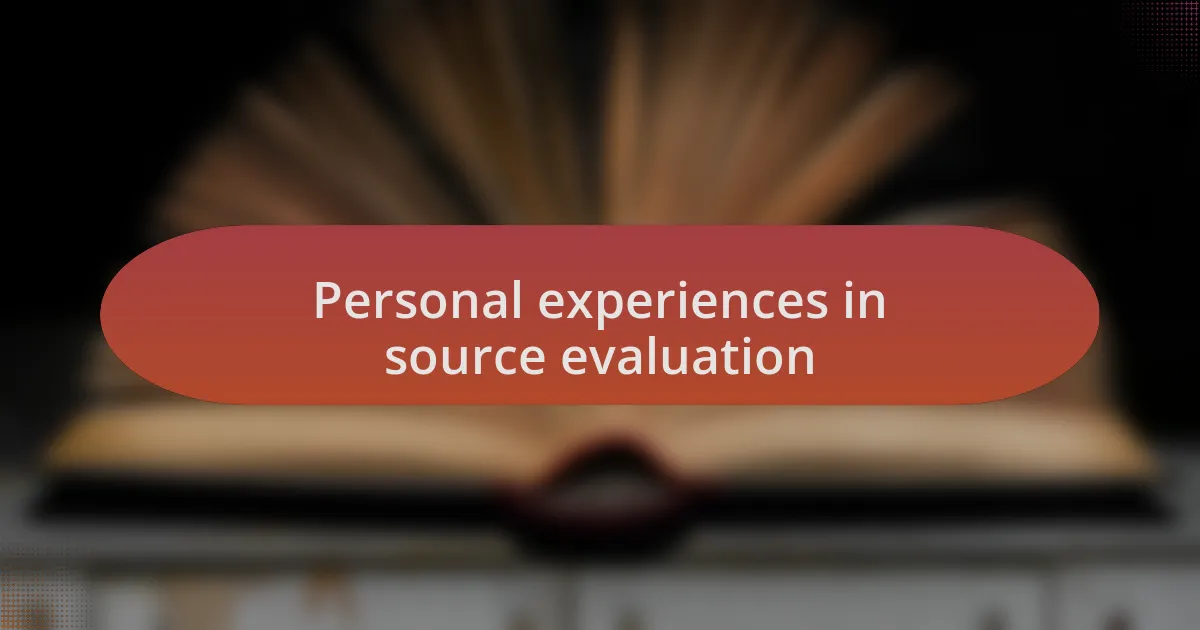
Personal experiences in source evaluation
Evaluating sources can sometimes feel overwhelming, especially when you’re faced with a trove of documents from various time periods. I remember the thrill of discovering a faded diary belonging to my great-grandmother. As I flipped through the pages, I felt an emotional connection to her struggles, but I also realized the importance of verifying her accounts against historical events. How much of her narrative was influenced by the biases of her time? I learned that personal experiences, while invaluable, can often be colored by perspective.
There was a time when I hit a wall with a family tree branch that just didn’t seem to fit. After obtaining a marriage certificate that didn’t match my expectations, I felt a mix of confusion and determination. It pushed me to go beyond the surface and demand answers—I ended up visiting local historical societies and speaking to distant relatives. These conversations opened new avenues of understanding about the lives my ancestors led, which wasn’t just about names and dates; it became a journey of connections and shared histories that reshaped my entire view of my lineage.
I vividly remember the day I compared two census records that seemed contradictory. At first glance, they listed different birth years for the same ancestor. Instead of dismissing one outright, I took a step back. This discrepancy made me wonder—what if each record had its own story to tell? Diving deeper, I found that local customs regarding recordkeeping varied significantly over the years. It was a powerful reminder that every source holds a potential story, waiting for someone to piece it together. Have you experienced something similar? The unraveling can reveal a much richer tapestry of your family’s past.
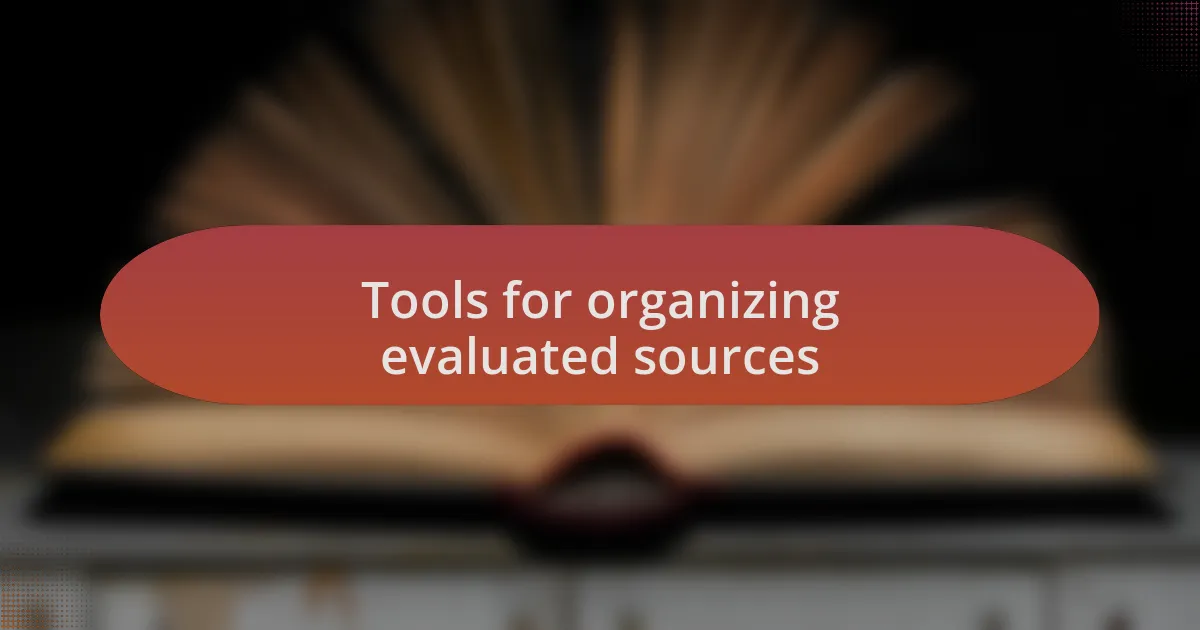
Tools for organizing evaluated sources
When it comes to organizing evaluated sources, I’ve found that digital tools can be incredibly helpful. For instance, I use software like Evernote to keep everything neatly cataloged. I can create notebooks for different branches of my family and add tags for specific events or documents. This way, I can quickly find information without digging through piles of paper.
Another tool that has transformed my workflow is a spreadsheet. I’m not a spreadsheet wizard, but I’ve learned to create simple trackers that include details like source title, date accessed, and the key takeaways for future reference. Whenever I add new information, I can easily see where a source fits into my research narrative and what gaps I still need to fill. Have you tried incorporating these types of tools into your own research?
Lastly, I want to mention apps like Trello for visual organization. I often find myself overwhelmed by the sheer volume of information I gather. By organizing my sources into boards labeled by type or family line, I gain clarity on my research progress. It’s like laying out a puzzle; suddenly, each piece feels less daunting, and the bigger picture starts to come into focus. How do you keep your sources organized?